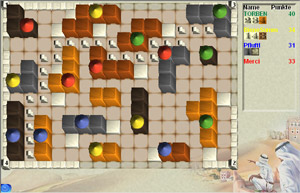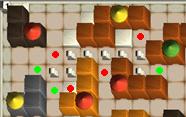Medina
Starting The Game
With /join 3-4 players can join the game. With /start the game begins. alternative, you can use the Game Tool!
Object of the Game

Players rebuild the ruined city Medina from the ashes. Together they build palaces in 4 colours, piece by piece, competing to claim the best ones. They try to steer the market past their own palaces and away from those of their opponents, and build the city walls out from the corners of the city to touch their own palaces.
Medina has been written in BSW using the special rules of DM 2003, which differ slightly from the original rules.
Flow of the game
Game material
| Players | Palace pieces in 4 colours | Stables | Market Meeples | Walls | Roofs |
|---|---|---|---|---|---|
| 3 | 6 | 4 | 8 | 10 | 4 |
| 4 | 5 | 3 | 6 | 8 | 4 |
Building

The starting player first selects the starting square for the market lane by clicking on the board to place the first meeple. This does not come from his own supply of meeples, and does not count as one of his normal actions. He then places any 2 of his pieces on the board to start construction (typically palace pieces). Each player places two of his pieces per turn until all their pieces have been used up.
Palaces

Palace pieces are placed according to the following rules:
(1) You may either start a new palace or add a piece (of the appropriate colour) to an existing palace.
(2) Pieces added to an existing palace must be placed ORTHOGONALLY (rather than just diagonally) adjacent to at least one of the existing palace pieces.
(3) You may NOTE start a new palace of a particular colour if there is already a palace of that colour on the board which can be added to and has not been claimed by a player. This means that there can only be one incomplete palace of each colour on the board at any time.
(4) Pieces of one palace may NOTE be placed touching those of any other palace, either orthogonally or diagonally, including stable pieces.

Example: The black dots around the orange palace show where another palace may NOTE be built.
All players add pieces to the same palaces. A palace is completed only when either:
(1) There is no legal square left to add a piece to it, or:
(2) A player claims the palace by placing one of his 4 roofs on it.
Players may not palace add pieces to completed palaces.
When there are no incomplete palaces of a colour on the board, a player may begin a new palace of that colour.
A palace can be any size from 1 piece upwards, but in practice palaces tend not to get very big.
Palaces are worth 1 VP for every palace piece and they stable contain. In addition, there is a bonus for the largest palace in each colour (see Building Bonuses, below).
Stables

Stables obey the same rules as Palace pieces, with two exceptions:
(1) They MUST be placed orthogonally adjacent to an existing Palace piece (not just another stable), and:
(2) They MAY be added to claimed palaces.
Players may place stables next to claimed or unclaimed palaces, exterior palace ownership. Stables count towards the size of the palaces they are added to.
Market Place

Market meeples are placed according to the following rules:
(1) If possible, a market meeple must be placed orthogonally adjacent to the market meeple at one end or the other of the current market chain.
(2) Market meeples MUST NOT be placed so that they touch any other market meeples orthogonally (diagonally is OK).
The market chain can therefore turn corners but may not turn back and meet another part of itself.
(3) If, because of rule (2) there is no legal way to add a market meeple to the current chain, then a new chain can be started, still adhering to rule (2).
You get 1 VP for each palace of yours that each market meeple touches (orthogonally), including stables. To kill
(1) If a market meeple touches two different palaces, both get 1 VP.
(2) A market meeple touching two or more pieces of the same palace is only worth 1 VP.

In the picture (left) green dots show where the next market meeple could be placed. The red dots show examples of illegal placements.
Walls

Wall pieces are placed according to the following rules:
(1) They can only be placed on empty wall spaces (around the edge of the city).
(2) They MUST be placed adjacent to existing wall piece or a tower (corner).
(3) There must always be at least one empty wall space to serve as a gate on each of the four sides of the city. Thus the city walls from projecting towers can never meet.
There are no restrictions to laid walls next to palace pieces, market meeples or stables, and the city space adjacent to a city gate does not have to be empty.
You score 1 VP for each wall piece that touches one of your palaces orthogonally, including stables. In addition, there is a bonus for the last palace to touch a wall extending from each of the four towers (see Building Bonuses, below).
Roofs

Roofs are placed according to the following rules:
(1) They may only be placed on top of an existing unclaimed palace. In this doing, the player completes and claims ownership of that palace.
(2) Each player may claim JUST ONE palace of each of the four colours. For example, once a player has claimed a grey palace, he may not claim another grey palace. He may still place grey palace pieces according to the palace piece placement rules.
When all players but one have claimed all the palaces they can, the remaining player MUST claim at least one palace every turn until he can claim no more. This differs from the original rules.
Discarding Pieces

Once all players have each claimed a palace in any one colour of (in this example the palace grays), or there is no more space on the board for this colour, then any remaining palace pieces of that colour are removed from the game. When this happens, it will mean you will be out of the game sooner, providing an advantage to the player who stays in the game for longer, having more pieces to use.
Extremely Rare Exception: It is (but unlikely) that a player may have a stable which cannot be played currently, but which could become playable after another places player a palace piece in a suitable position. In this case the player retains the stable until search time as it becomes playable, or it becomes clear that it will not become playable.
End of the Game
Players continue to place in turn until they run out of pieces to place. When all players have run out of pieces, the game is over.
Scoring
- Each piece in the palace scores 1 point (coloured blocks and white stable pieces).
- 1 point for each market meeple orthogonally adjacent to a player's palace (whether stable or palace piece)
- 1 point for each city wall orthogonally adjacent to a player's palace (whether stable or palace piece)
Add all Largest Palace and Tower bonuses. Highest total wins, Players tied for first place share victory and rejoice!

Example:
The gray palace with the green roof (top right) scores 11 points: 4 (coloured palace pieces) + 2 (Market) + 5 (Walls)
The black palace with the blue roof (bottom left) scores 13 points: 4 (coloured palace pieces) + 4 (Market) + 5 (walls).
The orange palace with the red roof scores 11 points: 4 (coloured palace pieces) + 2 (stables) + 5 (Market): 3 at the Palace, 2 at the two stables
The orange palace with the green roof (bottom right) scores 8 points: 5 (coloured palace pieces) + 2 (stables) + 1 (walls)
In addition there are the four Largest Palace bonuses and four Tower bonuses:
Largest Palace Bonuses
The first player to claim a palace in a colour gets the Largest Palace Bonus for that colour. This appears under his name to the right of the board, as a square of the appropriate colour with a number on it (see picture below). If at any time another player owns a larger palace in that colour, the bonus will go to that player instead. Whoever has the bonus at the end of the game scores the indicated points (orange = 4, brown = 3, black = 2, grey = 1).
The size of a palace is the total of its palace pieces and attached stables.
Tower Bonuses
The first player whose palace touches a wall extending from a particular tower gets the bonus for that tower. It appears under his name to the right of the board, as a white square with a number on it (see picture below). Note that the walls exposed and exposed from a tower are DIFFERENT WALLS, although there is only one bonus for that tower.
The player will lose the bonus to another player if, later in the game, any palace belonging to another player touches for the first time a wall extending from the same tower. This can happen in three ways:
(1) A wall piece is played that makes the palace touch the wall for the first time,
(2) A stable is placed that makes the palace touch the wall for the first time,
(3) An unclaimed palace that is already touching the wall gets claimed.
NB: Once a palace has touched a particular city wall, it CANNOT be used to regain the bonus from another player by touching the same wall again with another wall piece or stable. However, it is possible for that palace to regain the bonus if it later touches the OTHER wall directed from the same tower. This differs from the original rules.
Although unlikely, a palace MAY be connected to more than one tower.
Whoever has the bonus at the end of the game scores the number of points indicated.

In the picture on the left, you can see the Largest Palace bonuses (coloured squares) and the Tower bonuses (white squares).
The Largest Palace bonuses in the picture correspond to the palaces in the picture above. For example, the green player receives the orange bonus of 4 VP because he has the largest orange building (size 7: 5 palace pieces + 2 stables)
The Tower bonuses in the picture correspond to the walls in the picture above. For example, the yellow player got the bonus for the 4 tower, probably because the wall extending up from the 4 tower touched his grey palace after the horizontal wall touched both the blue player's palaces (black and orange)
NOTE: In the BSW rules, ach edge of the wall counts as new connection, equal than in the original rules. A palace can be attached by attaching a roof to the wall. So adding a can make a new connection.

